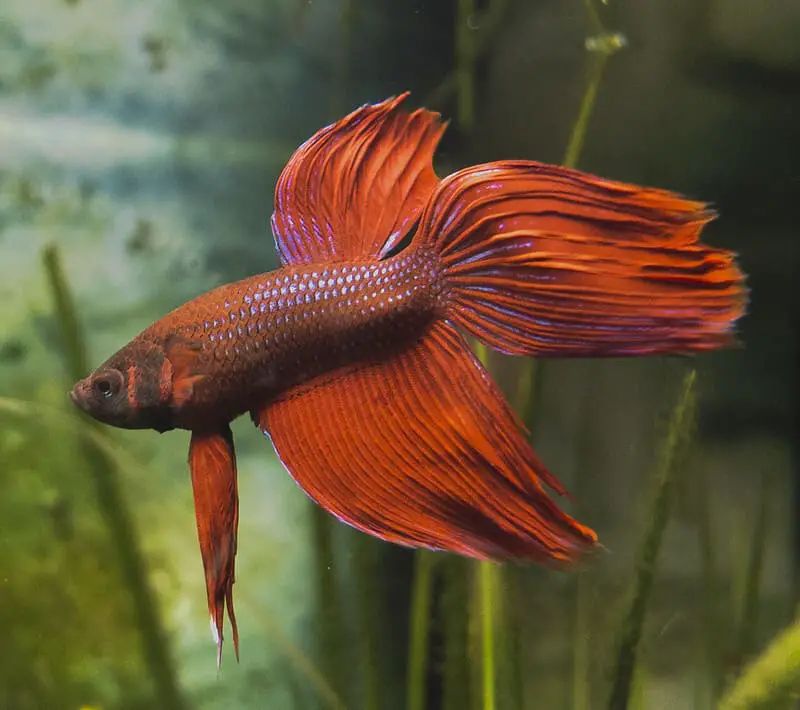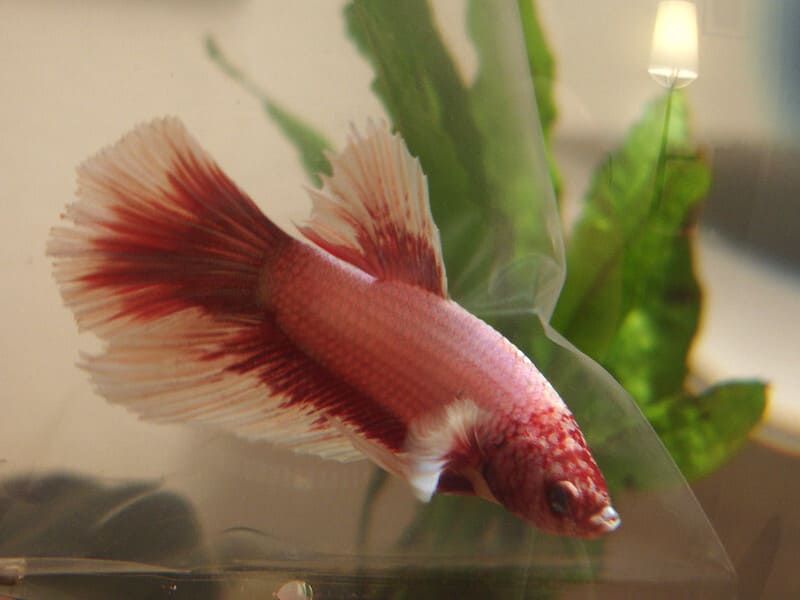Betta fish, also known as Siamese fighting fish, are renowned for their vibrant colors and flowing fins, making them popular choices for aquarium enthusiasts. Keeping betta fish with live aquatic plants can create a beautiful and natural underwater environment while offering several benefits for both the fish and the plants. In this comprehensive guide, we will explore the compatibility of betta fish with aquatic plants, the advantages of keeping them together, plant selection, care tips, and aquascaping techniques to create an aesthetically pleasing and harmonious ecosystem.

Part 1: Compatibility and Benefits
1. Compatibility of Betta Fish with Aquatic Plants
Betta fish can coexist harmoniously with aquatic plants, and this compatibility offers several advantages:
- Natural Habitat: In the wild, betta fish inhabit slow-moving and densely vegetated waters, such as rice paddies, marshes, and shallow streams. By adding live aquatic plants to their aquarium, you replicate their natural habitat.
- Hiding Spots: Aquatic plants provide hiding spots for bettas. These solitary and territorial fish appreciate the security and comfort of plant cover, reducing stress and aggression.
- Water Quality: Live plants can help maintain water quality by absorbing excess nutrients, providing oxygen, and reducing carbon dioxide levels. They also aid in the removal of harmful waste products, contributing to a healthier and more stable aquatic environment.
- Natural Filtration: Aquatic plants act as natural filters, reducing the need for mechanical filtration systems and frequent water changes. This makes maintaining the aquarium easier and less stressful for bettas.
- Oxygenation: Photosynthesis by aquatic plants releases oxygen into the water, ensuring a well-oxygenated environment for your betta fish.
- Algae Control: Live plants compete with algae for nutrients, potentially preventing or reducing the growth of nuisance algae in the aquarium.
2. Types of Aquatic Plants for Betta Tanks
Selecting the right aquatic plants for your betta tank is essential to create a suitable and aesthetically pleasing environment. Here are some popular choices:
- Anubias (Anubias spp.): Anubias are hardy, low-maintenance plants with broad, dark-green leaves. They are ideal for betta tanks because bettas rarely nibble on their leaves.
- Java Fern (Microsorum pteropus): Java ferns are another low-maintenance option with attractive green, wavy leaves. They can be tied to driftwood or rock for added visual appeal.
- Amazon Sword (Echinodorus spp.): Amazon swords are larger plants that can serve as a focal point in the tank. They have long, broad leaves and provide excellent cover for bettas.
- Java Moss (Taxiphyllum barbieri): Java moss is a popular choice for creating lush, underwater landscapes. It can be attached to driftwood or other décor.
- Water Wisteria (Hygrophila difformis): Water wisteria is a fast-growing plant that adds a dynamic element to the tank with its finely divided leaves. It offers excellent cover for bettas.
- Dwarf Hairgrass (Eleocharis parvula): For a grassy carpet effect, consider dwarf hairgrass. It creates a natural and visually appealing substrate cover.
- Floating Plants (e.g., Duckweed, Water Lettuce): Floating plants like duckweed and water lettuce provide shade and shelter for bettas. They also help diffuse light and reduce glare.
3. Care Tips for Aquatic Plants in Betta Tanks
To ensure the well-being of both your betta fish and aquatic plants, follow these care tips:
- Water Parameters: Maintain appropriate water parameters, including temperature (typically 78-80°F or 25-27°C), pH (around 7.0), and water hardness (soft to moderately hard).
- Lighting: Provide suitable lighting for your aquatic plants. Consider the light requirements of the specific plants you choose. LED lights designed for aquariums are often an excellent choice.
- Substrate: Use an appropriate substrate for plant growth. Many aquatic plants benefit from a nutrient-rich substrate or root tabs for optimal development.
- Fertilization: Depending on the plant species, you may need to supplement their nutrient intake with liquid or substrate fertilizers. Be cautious not to over-fertilize, as it can lead to algae issues.
- Pruning and Maintenance: Regularly trim and prune your plants to prevent overgrowth and ensure proper water circulation and access to light for all plants. Remove any dead or decaying plant material promptly.
- Aquascaping: Plan your aquascape carefully, considering the growth patterns and sizes of the plants you choose. Create an attractive layout that offers hiding spots and visual appeal.
- Water Changes: Perform routine water changes to maintain water quality. Water changes also help remove excess nutrients and waste products.
- CO2 Injection (Optional): If you have demanding plant species, you may consider adding a CO2 injection system to boost plant growth. However, this is not always necessary for a betta tank with low to moderate plant requirements.

Part 2: Aquascaping Techniques
Creating a visually pleasing and functional aquascape in your betta tank involves careful planning and arrangement of plants, substrate, and décor. Here are some popular aquascaping techniques for betta tanks:
1. Dutch Style Aquascape
The Dutch style aquascape is characterized by the use of numerous plant species with different colors, shapes, and sizes. It creates a lush and heavily planted aquarium with a well-organized layout. This style can provide an engaging and visually appealing environment for bettas.
Key Elements:
- Layered Planting: Arrange plants in rows or layers, with taller species at the back and shorter ones in the foreground.
- Variety: Use a wide variety of plant species to create a diverse and colorful aquatic garden.
- Background: Select tall and bushy plants for the background to provide shelter and cover for bettas.
- Foreground Plants: Choose low-growing species or carpeting plants for the front of the tank.
2. Iwagumi Style Aquascape
The Iwagumi style is characterized by simplicity and minimalism. It often features rock structures and a limited number of plant species. This style can create a tranquil and Zen-like atmosphere in your betta tank.
Key Elements:
- Stones: Use a few well-selected stones as the primary décor element. They are typically arranged in a triangular or asymmetrical layout.
- Substrate: Use fine, light-colored substrate to contrast with the stones.
- Minimal Planting: Select only one or a few plant species, such as carpeting plants or small, delicate species.
- Negative Space: Iwagumi aquascapes often include open areas or negative space to create a sense of balance and harmony.
3. Jungle Style Aquascape
The jungle style aquascape aims to replicate the appearance of a dense, overgrown forest. It can provide an abundance of hiding spots and cover for bettas while creating a vibrant and natural look.
Key Elements:
- Plant Density: Plant the tank densely, allowing the plants to grow freely and create a jungle-like environment.
- Variety of Plant Heights: Mix tall, bushy plants with lower-growing species to create layers and a sense of depth.
- Hardscape Elements: Include driftwood, branches, or other natural décor items to mimic a wild habitat.
- Low Maintenance: Jungle style aquascapes are often low-maintenance, making them suitable for beginner aquascapers.
4. Biotope Aquascape
A biotope aquascape aims to replicate a specific natural habitat, such as the Betta splendens’ native waters in Southeast Asia. This style provides an authentic and educational experience for betta keepers.
Key Elements:
- Research: Study the specific biotope you wish to replicate and select plant and décor elements accordingly.
- Native Plants: Choose aquatic plants that are native to the selected region to create an authentic environment.
- Habitat Features: Incorporate natural habitat features like rocks, branches, and leaf litter to complete the biotope.
5. Planted Bowl or Jar
For those looking to create a miniature, self-contained ecosystem, consider a planted bowl or jar aquascape. These small setups can be visually striking and low-maintenance.
Key Elements:
- Select a Bowl or Jar: Choose a glass container with a lid or cover.
- Substrate: Add a layer of substrate and carefully selected aquatic plants.
- Low-Light Plants: Opt for low-light and low-maintenance plant species.
- Closed Ecosystem: Once the jar or bowl is sealed, it becomes a self-sustaining ecosystem with minimal external maintenance.

Part 3: Additional Considerations
1. Tank Size and Water Parameters
Ensure that your betta tank is appropriately sized and the water parameters are suitable for both the fish and the plants. Betta fish generally do well in tanks of 5 gallons or more. Maintain stable water conditions, including temperature, pH, and hardness, to support healthy plant growth.
2. Compatibility with Other Tankmates
Consider the compatibility of betta fish with other tankmates, as this can impact both the fish and the plants. Some fish and invertebrates can coexist peacefully with bettas, while others may be territorial or pose a threat to your plants.
3. Betta Personality
Each betta fish has a unique personality and temperament. Some bettas are more aggressive and territorial, while others are more docile. Consider your betta’s individual behavior when selecting tankmates and arranging the aquascape.
4. Observation and Maintenance
Regularly observe your betta fish and the condition of the plants. Pay attention to any signs of stress, aggression, or illness in your betta. Adjust the aquascape or make changes as needed to accommodate your betta’s preferences.
5. Disease Prevention
To protect both your betta fish and the aquatic plants, practice disease prevention. Quarantine new plants before adding them to the tank to avoid introducing pests or diseases. Maintain good water quality to prevent stress and diseases in bettas.
Conclusion
Keeping betta fish with aquatic plants can create a visually stunning and natural underwater environment while providing numerous benefits for both the fish and the plants. By carefully selecting suitable plant species, following care tips, and exploring various aquascaping techniques, you can create a harmonious and thriving ecosystem in your betta tank.
Remember to consider your betta’s personality and preferences, as well as their compatibility with tankmates and the overall well-being of the fish and plants. With proper care and attention, your betta and aquatic plants can coexist happily in a beautiful and captivating aquatic world.
